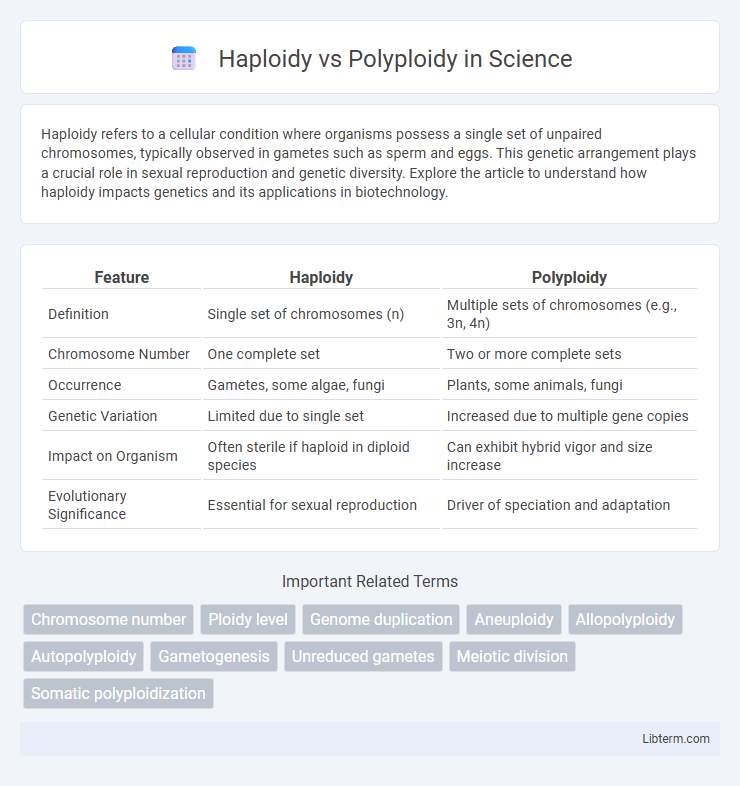Haploidy refers to a cellular condition where organisms possess a single set of unpaired chromosomes, typically observed in gametes such as sperm and eggs. This genetic arrangement plays a crucial role in sexual reproduction and genetic diversity. Explore the article to understand how haploidy impacts genetics and its applications in biotechnology.
Table of Comparison
| Feature | Haploidy | Polyploidy |
|---|---|---|
| Definition | Single set of chromosomes (n) | Multiple sets of chromosomes (e.g., 3n, 4n) |
| Chromosome Number | One complete set | Two or more complete sets |
| Occurrence | Gametes, some algae, fungi | Plants, some animals, fungi |
| Genetic Variation | Limited due to single set | Increased due to multiple gene copies |
| Impact on Organism | Often sterile if haploid in diploid species | Can exhibit hybrid vigor and size increase |
| Evolutionary Significance | Essential for sexual reproduction | Driver of speciation and adaptation |
Introduction to Haploidy and Polyploidy
Haploidy refers to cells or organisms possessing a single set of chromosomes (n), crucial for gamete formation in sexual reproduction. Polyploidy involves multiple sets of chromosomes (e.g., diploid 2n, triploid 3n, or tetraploid 4n), significantly impacting genetic diversity and evolution in plants and some animals. These chromosomal variations influence developmental processes, adaptation mechanisms, and breeding strategies in agriculture and biotechnology.
Defining Haploidy: Characteristics and Examples
Haploidy refers to cells or organisms having a single set of unpaired chromosomes (n), typical in gametes like sperm and egg cells in animals and spores in plants. This genetic condition is crucial for maintaining chromosome number during sexual reproduction and for genetic diversity through processes such as meiosis. Examples of haploid cells include human sperm and ova, yeast spores, and pollen grains in flowering plants.
Defining Polyploidy: Characteristics and Examples
Polyploidy refers to the condition in which an organism possesses more than two complete sets of chromosomes, commonly observed in plants such as wheat (hexaploid) and strawberries (octoploid). This genetic state enhances traits like increased size, greater environmental adaptability, and higher fertility compared to haploid counterparts that contain a single chromosome set. Polyploidy plays a crucial role in speciation and evolutionary diversification, contributing to agricultural improvements and biodiversity.
Mechanisms Behind Haploidy Formation
Haploidy formation primarily occurs through mechanisms like genome elimination, where one parental set of chromosomes is selectively lost during embryogenesis, and uniparental chromosome elimination in wide crosses between species. Another key process involves parthenogenesis, asexual reproduction where an embryo develops from an unfertilized egg, maintaining a single set of chromosomes. These mechanisms contribute to haploid induction, which is crucial in plant breeding for generating homozygous lines rapidly.
Mechanisms Behind Polyploidy Formation
Polyploidy formation primarily occurs through errors in meiosis or mitosis, leading to the doubling of chromosome sets within an organism. Mechanisms such as nondisjunction during cell division result in gametes with extra chromosome sets, which upon fertilization generate polyploid offspring. Autopolyploidy arises from chromosome duplication within a single species, while allopolyploidy involves hybridization between different species followed by chromosome doubling.
Genetic and Evolutionary Significance
Haploidy involves a single set of chromosomes, facilitating rapid genetic mutations and adaptation in organisms like fungi and algae, while polyploidy, characterized by multiple chromosome sets, promotes genetic diversity and speciation in plants and some animal lineages. Polyploidy often results in increased cell size, hybrid vigor, and can lead to reproductive isolation, driving evolutionary divergence and the emergence of new species. This chromosomal variation underpins key evolutionary mechanisms, influencing genome evolution, adaptability, and the ecological success of diverse organisms.
Haploidy vs Polyploidy in Plant Breeding
Haploidy in plant breeding involves using plants with a single set of chromosomes, which accelerates the development of homozygous lines for trait fixation and genetic studies. Polyploidy, the condition of having multiple chromosome sets, enhances genetic diversity, vigor, and adaptation potential, often leading to improved crop yields and stress resistance. Techniques like anther culture produce haploids rapidly, while induced polyploidy through chemicals such as colchicine creates polyploids, both playing vital roles in crop improvement strategies.
Advantages and Disadvantages of Haploidy
Haploidy offers advantages such as rapid genetic analysis and the expression of recessive alleles, facilitating efficient breeding and genetic studies. However, haploid organisms often exhibit reduced vigor and fertility, limiting their survival and reproductive success compared to diploid or polyploid counterparts. The simplicity of haploid genomes accelerates mutation detection but poses challenges in adaptability and resilience under environmental stress.
Advantages and Disadvantages of Polyploidy
Polyploidy provides advantages such as increased genetic diversity, enhanced cell size, and greater adaptability to environmental changes, which can lead to improved crop yield and stress resistance. However, polyploidy also presents disadvantages including meiotic irregularities, reduced fertility due to chromosome pairing issues, and potential developmental abnormalities. This balance of benefits and drawbacks influences the evolutionary success and agricultural use of polyploid organisms.
Applications and Future Perspectives
Haploidy, characterized by a single set of chromosomes, enables rapid genetic screening and development of homozygous lines in plant breeding, accelerating crop improvement and hybrid seed production. Polyploidy, involving multiple chromosome sets, enhances genetic diversity, stress tolerance, and biomass, making it crucial for improving agricultural productivity and developing novel plant varieties. Advances in genome editing and biotechnological tools promise to refine haploid and polyploid manipulation, expanding their applications in sustainable agriculture and crop resilience against climate change.
Haploidy Infographic

 libterm.com
libterm.com